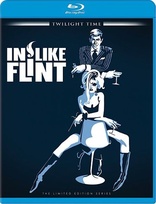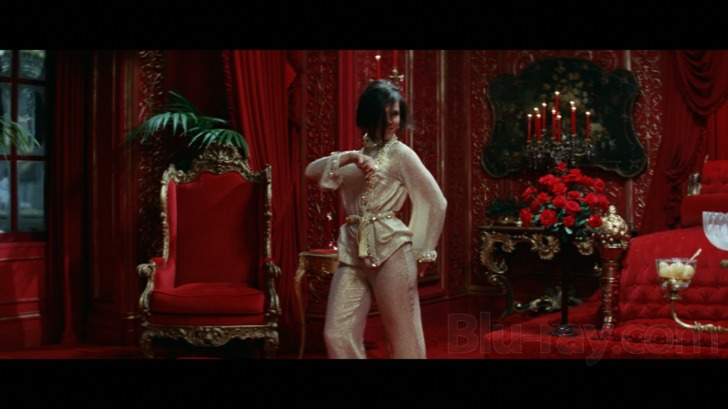In Like Flint Blu-ray Movie
HomeIn Like Flint Blu-ray Movie 
Limited Edition to 3000 - SOLD OUTTwilight Time | 1967 | 115 min | Not rated | Feb 12, 2013

Movie rating
6.8 | / 10 |
Blu-ray rating
| Users | 4.0 | |
| Reviewer | 4.0 | |
| Overall | 4.0 |
Overview
In Like Flint (1967)
Super-spy Flint takes on a cabal of women plotting to rule the world.
Starring: James Coburn, Lee J. Cobb, Jean Hale, Andrew Duggan, Anna Lee (I)Director: Gordon Douglas
| Comedy | Uncertain |
| Adventure | Uncertain |
| Action | Uncertain |
Specifications
Video
Video codec: MPEG-4 AVC
Video resolution: 1080p
Aspect ratio: 2.35:1
Original aspect ratio: 2.35:1
Audio
English: DTS-HD Master Audio 5.1 (48kHz, 24-bit)
English: DTS-HD Master Audio Mono (48kHz, 24-bit)
Music: DTS-HD Master Audio 2.0 (48kHz, 24-bit)
Subtitles
English SDH
Discs
50GB Blu-ray Disc
Single disc (1 BD)
Playback
Region free
Review
Rating summary
| Movie | 3.5 | |
| Video | 4.5 | |
| Audio | 4.5 | |
| Extras | 4.5 | |
| Overall | 4.0 |
In Like Flint Blu-ray Movie Review
Pure Gold(smith).
Reviewed by Jeffrey Kauffman February 15, 2013Note: This review will depart from our usual practice and focus fairly exclusively on only one element of this
particular film, namely the wonderful score by Jerry Goldsmith, which has long been a personal favorite of mine.
Do you believe in astrology? I’ve joked for years that the fact that Stephen Sondheim (whom I consider to be the
preeminent genius of contemporary musical theater composers) and Andrew Lloyd Webber (whom I consider to be—
well, not the preeminent genius of contemporary musical theater composers) were born on the same day is
“proof positive” that astrology is a bunch of hokum. Now of course proponents of this so-called “Mystical Art” will no
doubt point out that Sondheim and Webber were born in different years and different places, making their “star charts”
completely disparate, but this sharing of birthdays at least might put the lie to the “cut and paste” horoscopes that
“seers” like Sydney Omarr used to post in daily newspapers, forecasts that seemingly took six or seven
interchangeable phrases and simply distributed them among the zodiacal signs in varying orders from day to day. (This
also brings to mind a favorite family anecdote from when our boys were quite young. We had taken our youngest son
out to buy him clothes for either kindergarten or first grade, and then we all went to a Chinese restaurant for dinner.
We got our attendant fortune cookies, and my youngest son opened his to read, “You will soon have new clothes”. He
looked up at us and without the slightest bit of irony asked, “Hey, what kind of a crappy fortune is this?”) I am
off on this perhaps blathering tangent for one salient reason: years ago when I was still in college I had my horoscope
done by a professional astrologer, and while a lot of what he told me that day turned out to be, well, tangential
blather, one interesting element from my chart turned out to be absolutely correct. I can’t tell those of you who know a
lot about astrology the pertinent “technical” details, but my chart is very unusual in that I have all but one of my planets
crowded together in just a couple of houses. A solitary planet is in the tenth house, the house of career, and it is
evidently retrograde (whatever that means) in some sign that indicates, in the words of this astrologer, “Zowie—are
you going to have an unusual career!” That turned out to manifestly be the case, for aside from doing penance
in a variety of fairly boring office jobs early in my professional life, I’ve had the unusual situation of making my living
both from music and writing for the bulk of the past couple of decades. And so without further ado, I’d like to talk just a
bit about Jerry Goldsmith and his fantabulous work on the Flint films, drawing perhaps as much from my musical
background as my film analysis one.

It’s perhaps indicative of another “mystical art”, namely synchronicity, that my long ago astrologer had said “zowie” when assessing my prospects for making my living, for Z.O.W.I.E. is the acronym for the supersecret international spy agency for whom superspy Derek Flint (James Coburn) works in both of the Flint films. (The first Flint outing, Our Man Flint, was released by Twilight Time last month). Jerry Goldsmith and lyricist Leslie Bricusse decided to utilize that unusual word in their theme song for this second Flint feature, a charming tune called “Your Zowie Face” which (not to be overly technical) utilizes a nice ii-V motive which ascends by minor thirds, giving the song an undeniable forward momentum. Now Leslie Bricusse is a writer who (in my estimation at least) comes in for some unfair brickbats a lot of the time (I’ve felt for years that his scores for the musical films Goodbye, Mr. Chips and most especially Scrooge have been unfairly maligned), but even his staunchest defenders might admit that his lyric for “Your Zowie Face” strains to incorporate ideas from the film into its ostensible “love story”. But Goldsmith’s music? That’s another matter entirely.
The mid-sixties were awash in all sorts of musical adventurism, with The Beatles having introduced all sorts of new vocabulary to pop music writing, and everything from soul to quasi-big band formulations beginning to appear on the charts courtesy of everyone from Aretha Franklin to Blood, Sweat & Tears. But one of the more interesting things that had unexpectedly found some second wind was the Bossa Nova phenomenon, which had begun in the late fifties with the release of Black Orpheus, and then gone on to worldwide obsession status with recordings by Stan Getz and Joao Gilberto (and Joao’s then-wife, Astrud, who found herself rather suddenly thrust into the pop culture spotlight simply because she had accompanied her husband to a recording session and ending up singing “The Girl from Ipanema”, resulting in a huge global hit). But the Bossa Nova craze had already shown signs of dissipating by as early as 1964 or so, until pianist Sergio Mendes regrouped what had been called Brasil ’65 into his new formulation Brasil ’66. Mendes had the good luck to partner musically with Herb Alpert, who was then arguably the biggest name in domestic music (outselling even The Beatles), and under Alpert’s aegis, Mendes took off on a multi-year success story that saw his unique blend of Bossa Nova, pop and rock elements resulting in five gold albums in a row and a number of huge hit singles. Suddenly Brazilian rhythms were all the rage again, and they became a staple of both films and television for the remainder of the sixties, including a lot of work by Mendes' most frequent orchestrator, Dave Grusin.
It was in this environment that Goldsmith did something quite remarkable in terms of his score for In Like Flint. He took the basic Bossa Nova syncopations and sinuous rhythms, but he set “Your Zowie Face” (which also provides the source elements for the vast bulk of Goldsmith's underscore) not in the standard Bossa Nova time signature of 4/4, but 3/4, more typically the time signature for waltzes (and jazz waltzes). Goldsmith in fact tends to walk a rather delicate tightrope between jazz waltz and Bossa Nova idioms throughout his score for In Like Flint, and his contributions are one of the film’s most lasting pleasures. (Interestingly, Mendes himself would flirt with 3/4 just a bit later in his career, with one of his biggest singles, his version of The Beatles’ “The Fool On the Hill”, which Mendes rethought in alternating 3/4 and 4/4 sequences. A year or so later Mendes recorded the charming jazz waltz “Some Time Ago” and invested it with much the same Bossa Nova charm as informs Goldsmith’s In Like Flint score.)
Now some of you may be thinking, “Who cares?”, but I would respond to those folks that the music of any film, while perhaps often (intentionally) subliminal, affects the overall experience as much as more obvious elements like the actors or direction. And in the case of In Like Flint, Goldsmith’s contributions are inestimable, creating both an exotic undercurrent as well as both a romantic and a more traditional “Bond-ian” influence that beautifully supports and actually improves this tongue in cheek second Flint film. The multilayered use of percussion throughout the film exerts an undeniably propulsive element that in some ways is reminiscent of another great film and television writer who tended to utilize Latin (if not exclusively Bossa Nova) elements in his writing, the great Lalo Schifrin (Mission: Impossible, Mannix).
In terms of its non-musical elements, In Like Flint is at least somewhat of a more mixed bag than the first Flint outing, and in fact may strike some as more outrageously sexist than even the first Playboy-esque Flint film, a rather ironic fact considering the fact that the baddies in this film are a bunch of proto-feminists intent on world domination. This second Flint film doesn’t quite have the breeziness of Our Man Flint, and seems a trifle more forced, especially with regard to its comedic aspects. There’s still fun to be had in In Like Flint, though few might end up agreeing with erstwhile superspy Austin Powers that it’s their favorite film. But for those who pay attention to supposedly “ignorable” elements like a film’s score, In Like Flint will always have a lot to recommend it.
In Like Flint Blu-ray Movie, Video Quality 

In Like Flint Is presented on Blu-ray courtesy of Twilight Time with an AVC encoded 1080p transfer in 2.35:1. For whatever reason, this is a noticeably sharper and generally crisper looking high definition presentation than Our Man Flint was. Colors are beautifully saturated and very robust, and the image retains a general level of clarity, especially with regard to the center of the frame, that was occasionally missing in the first film. Fine detail pops at admirable levels, especially in close-ups. There is some stock footage here (like the establishing shot of Washington, D.C.) that looks pretty shoddy when compared to the bulk of the film, but otherwise this is a sterling presentation and one of the nicer looking Fox titles we've seen from Twilight Time. Even with the copious supplements, everything is quite comfortably placed on a BD-50, so no compression artifacts were noticeable.
In Like Flint Blu-ray Movie, Audio Quality 

In Like Flint features the film's original mono track delivered via a lossless DTS-HD Master Audio 1.0 mix, as well as a repurposed DTS-HD Master Audio 5.1 mix that is still fairly front heavy but which does significantly open up both Goldsmith's score as well as some of the action elements (which are replete with a lot of sound effects). Fidelity is very strong on both tracks, with dialogue, score and effects extremely cleanly presented and very well prioritized. Dynamic range is suitably wide.
In Like Flint Blu-ray Movie, Special Features and Extras 

- Audio Commentary with Film Historians Lee Pfeiffer and Eddy Friedfeld. This is another highly enjoyable, if occasionally a little saucy, commentary that delves into quite a bit of background material on the film and franchise, as well as some choice anecdotes about James Coburn.
- Isolated Score by Jerry Goldsmith is presented via DTS-HD Master Audio 2.0. Anyone who claims these isolated scores are not worthwhile should have their heads (and/or ears) examined. We get Goldsmith calling out take numbers (Take 25 for the opening theme? Zowie!) and other associated chitchat along with the actual music.
- Derek Flint: The Secret Files (1080p; 15:43) looks at the franchise and how this sequel came to be.
- James Coburn: The Man Beyond the Spy (1080p; 14:55) is a profile of the actor.
- Designing Flint (1080p; 11:30) looks at both Flint films' production design.
- Flint vs. Zanuck: The Missing 3 Minutes (1080p; 7:09) is a really interesting featurette that actually deals with Saul David's battles with the Zanuck fils. The edits Zanuck insisted on may not really amount to much, but they're fun to hear about.
- Take It Off (480p; 8:41) is a vintage featurette that may raise the ire of feminists.
- Puerto Rico Premiere (480p; 11:42) features Art Linkletter and Sammy Davis, Jr.
- Screen Test (480p; 2:15) features Diane Lund.
- Future Perfect (480i; 7:28) is a fun look at the "futuristic" elements of the Flint films.
- Feminine Wiles (480i; 6:19) looks at the so called "gender politics" on display in In Like Flint.
- Spy School (480i; 6:28) compares film spies to those in the real world.
- Musician's Magician (480i; 5:11) is a sweet but way to brief profile of Jerry Goldsmith, including interviews with his children.
- Spy Vogue (480i; 5:59) is another look at the film's design aesthetic.
- Trailer #1 (480p; 00:55)
- Trailer #2 (480p; 3:22) is actually a trailer for The Quiller Memorandum. Could this be a hint from Twilight Time?
In Like Flint Blu-ray Movie, Overall Score and Recommendation 

In Like Flint may not be quite as much fun as Our Man Flint, but it's a highly enjoyable romp nonetheless. Coburn's just slightly smarmy style is perfectly suited to this role, and while this film may raise the hackles of ardent feminists, it's still a rather potent time capsule back to the late sixties and the dawn of the Sexual Revolution. This Blu-ray boasts stellar video and audio and comes jam packed with fantastic supplements. I'm obviously highly biased toward this film due to my long love of Jerry Goldsmith's wonderful score, so you might want to factor that into my decision to state this release comes Highly recommended.
Similar titles
Similar titles you might also like

Our Man Flint
Limited Edition to 3000 - SOLD OUT
1966

Mission: Impossible: The Original TV Series
1966-1973

What's New Pussycat?
1965

The Loved One
Warner Archive Collection
1965

The President's Analyst
Special Edition
1967

Skidoo
1968

Target
1985

Fantastic Voyage
Fox Studio Classics
1966

Come Blow Your Horn
1963

The Wheeler Dealers
Warner Archive Collection
1963

Against All Flags
1952

The Odd Couple
1968

Arabian Nights
1942

Fathom
Canceled Release
1967

Casino Royale
1967

Doc Savage: The Man of Bronze
Warner Archive Collection
1975

The Sea Hawk
Warner Archive Collection
1940

When Eight Bells Toll
Special Edition
1971

The Time Tunnel: The Complete Series
1966-1967

The World in His Arms
1952